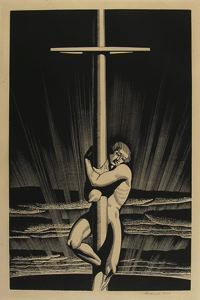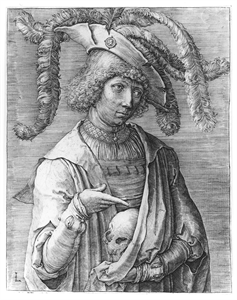
Rockwell Kent
American, 1882–1971
Kent's "Sea and Sky" was produced as a wood engraving in an edition of 150. The design was one of twelve that were commissioned from the artist by the American Car and Foundry Company, and that were subsequently used in advertising campaigns by the company between July, 1930 and August, 1931. "Sea and Sky" was the ninth in the series and was published in popular periodicals in March of 1931. In general, the theme of the works commissioned by the company addressed mankind's efforts to escape the limitations of his earth-bound existance and connect with the infinite.
The artist began his wood engraving designs as drawings in reverse, which he then transferred to blocks of maple, cutting the details into the wood. Kent's spare and sharply linear style lent itself to interpretation in this way. Kent was primarily a painter of oils, however he produced wood engravings, woodcuts, and lithographs, which he thought of as more accessible art forms for the general public.
This image of a man clinging to what appears to be a ship’s mast became an icon of sorts for Americans during the earliest years of the Great Depression. It gives an impression of timelessness, set against a dark sky with rays of light extending up from the sea below. The form of the mast creates a cross, formally referencing the Christian crucifixion. It suggests that Americans must find spiritual solace in nature, and in faith, as they await a brighter day.
American, 1882–1971
Sea and Sky
1931
Object Type:
Print
Dimensions:
10 in. x 6 1/2 in. (25.4 cm x 16.51 cm)
Medium and Support:
Wood engraving on paper
Accession Number:
1934.0006
Credit Line:
Montgomery Museum of Fine Arts Association Purchase
Kent's "Sea and Sky" was produced as a wood engraving in an edition of 150. The design was one of twelve that were commissioned from the artist by the American Car and Foundry Company, and that were subsequently used in advertising campaigns by the company between July, 1930 and August, 1931. "Sea and Sky" was the ninth in the series and was published in popular periodicals in March of 1931. In general, the theme of the works commissioned by the company addressed mankind's efforts to escape the limitations of his earth-bound existance and connect with the infinite.
The artist began his wood engraving designs as drawings in reverse, which he then transferred to blocks of maple, cutting the details into the wood. Kent's spare and sharply linear style lent itself to interpretation in this way. Kent was primarily a painter of oils, however he produced wood engravings, woodcuts, and lithographs, which he thought of as more accessible art forms for the general public.
This image of a man clinging to what appears to be a ship’s mast became an icon of sorts for Americans during the earliest years of the Great Depression. It gives an impression of timelessness, set against a dark sky with rays of light extending up from the sea below. The form of the mast creates a cross, formally referencing the Christian crucifixion. It suggests that Americans must find spiritual solace in nature, and in faith, as they await a brighter day.
Keywords
Click a term to view the records with the same keyword
Portfolio List
Click a portfolio name to view all the objects in that portfolio
This object is a member of the following portfolios:
Your current search criteria is: All Object records.

 by Artist (743)
by Artist (743)
